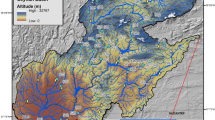Abstract
The crustacean zooplankton communities of seven, small, eutrophic West Virginian impoundments were examined during midsummer. The more eutrophic lakes had as dominants, 2 cyclopoid, 1 calanoid, and 2 cladoceran species. Cluster analysis showed that the 4 more eutrophic lakes clustered together, further cluster analysis showed there was a very similar group of 5 species which characterized the most eutrophic lakes. Principal components analysis showed that the more eutrophic lakes were characterized by having more cyclopoids and cladocerans than calanoids. Niche breadth showed that the most often dominant species had much higher ⊝ values than the species ohich could be considered secondary dominants.
Similar content being viewed by others
References
Anderson, R. S. 1974. Crustacean plankton communities of 340 lakes and ponds in and near the National Parks of the Canadian Rocky Mountains. J. Fish. Res. Bd. Canada. 31: 855–869.
Gannon, J. E. 1972. Effects of eutrophication and fish predation on recent changes in zooplankton Crustacean species composition in Lake Michigan. Trans. Amer. Micros. Soc. 91: 82–84.
Golterman, H. L. 1969. Methods for chemical analysis of freshwaters. I.B.P. Handbook No. 8. Blackwell Sci. Pub. Oxford. 166 pp.
Goulden, C., Hornig, L. & Wilson, C. (In press). Why do large zooplankton species dominate? Verh. Internat. Verein. Limnol. 20.
Janicki, A. & DeCosta, J. (In press). A multivariate analysis of the crustacean plankton community of an acid reservoir. Arch. Hydrobiol.
Levins, R. 1968. Evolution in changing environments. Princeton Univ. Press, Princeton. 120 p.
McNaught, D. C. 1975. A hypothesis to explain the succession from calanoids to cladocerans during eutrophication. Verh. Internat. Verein. Limnol. 19: 724–731.
Patalas, K. 1971. Crustacean plankton communities in forty-five lakes in the Experimental Lakes Area, northwestern Ontario. J. Fish. Res. Bd. Canada. 28: 231–244.
Patalas, K. 1972. Crustacean plankton and the eutrophication of St. Lawrence Great Lakes. J. Fish. Res. Bd. Canada. 29: 1451–1462.
Patalas, K. 1975. The crustacean plankton communities of fourteen North American great lakes. Verh. Internat. Verein. Limnol. 19: 504–511.
Patalas, K. & Salki, A. 1973. Crustacean plankton and the eutrophication of lakes in the Okanagan Valley, British Columbia. J. Fish. Res. Bd. Canada. 30: 519–542.
Sprules, W. G. 1977. Crustacean zooplankton communities as indicators of limnological conditions: an approach using principal components analysis. J. Fish. Res. Bd. Canada. 34: 962–975.
Strickland, J. D. H. & Parsons, T. R. 1965. A practical handbook for sea water analysis. 2nd Edition. 203 pp.
Watson, N. H. F. 1974. Zooplankton of the St. Lawrence Great Lakes — species composition, distribution, and abundance. J. Fish. Res. Bd. Canada. 31: 783–794.
Zaret, T. M. (In press). A predation model of zooplankton community structure. Verh. Internat. Verein. Limnol. 20.
Author information
Authors and Affiliations
Rights and permissions
About this article
Cite this article
Janicki, A.J., Decosta, J. & Davis, J. The midsummer crustacean plankton communities of seven small impoundments. Hydrobiologia 64, 123–129 (1979). https://doi.org/10.1007/BF00023187
Received:
Published:
Issue Date:
DOI: https://doi.org/10.1007/BF00023187




